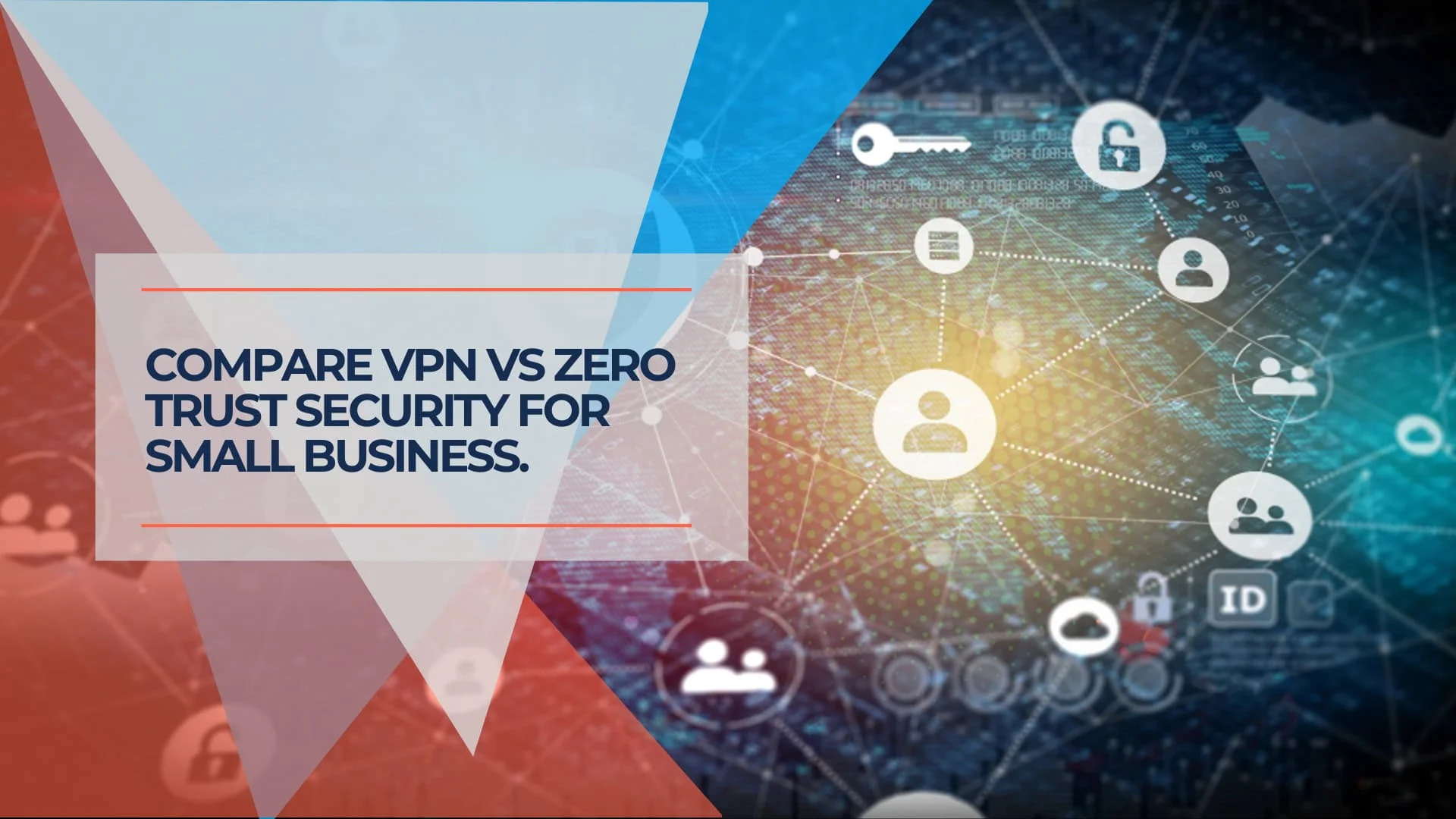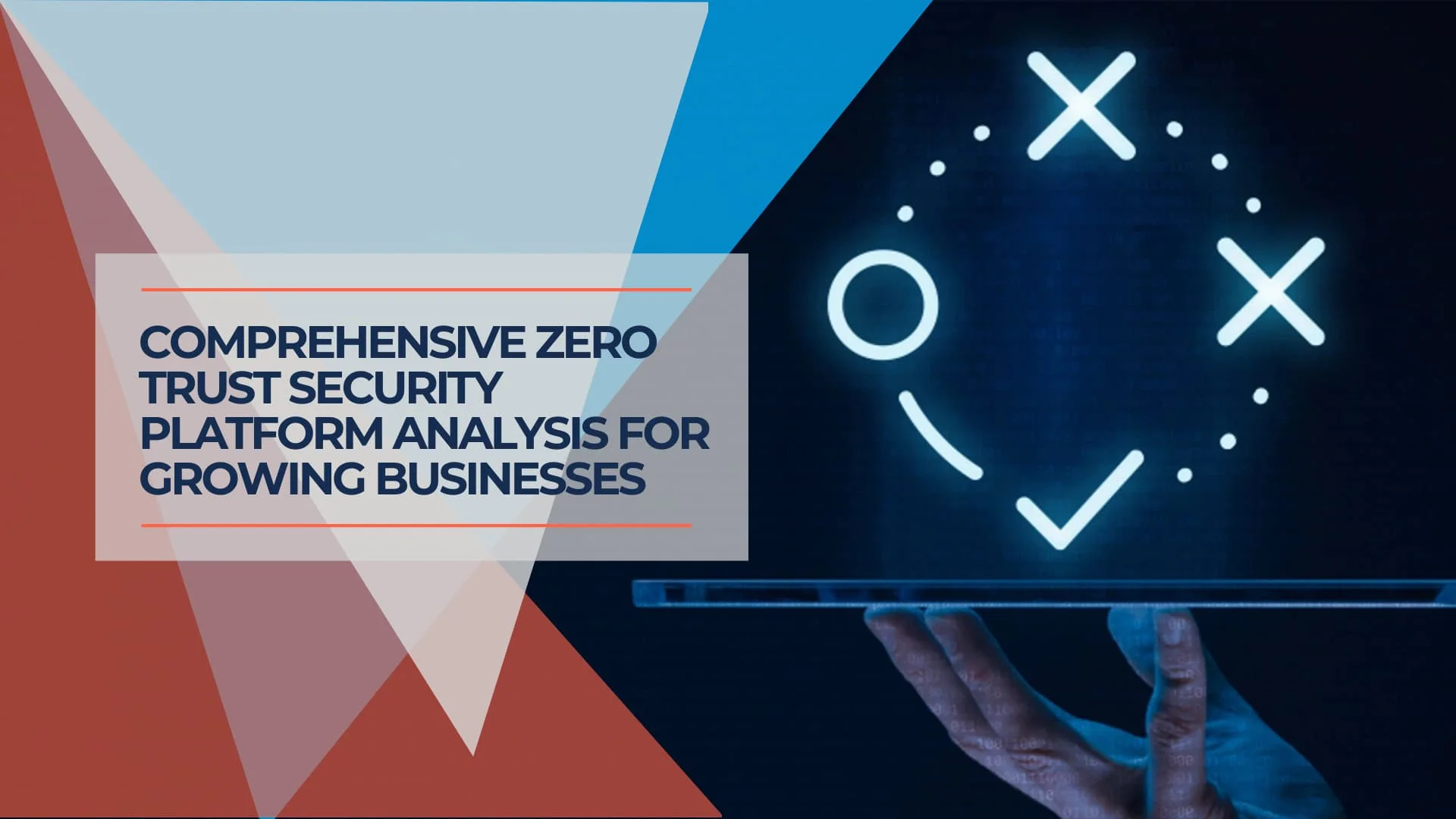VPN vs. Zero-Trust: Why SMBs Should Upgrade Before 2026
Compare VPN and Zero Trust Network Access (ZTNA) for small businesses. Learn implementation costs, security benefits, and practical migration steps for SMBs.


Key Takeaway
Research from Gartner indicates that 70% of new remote access deployments will use Zero Trust Network Access (ZTNA) instead of traditional VPNs by 2025. Meanwhile, the Zscaler ThreatLabz 2025 VPN Risk Report found that 92% of organizations are concerned about ransomware attacks due to VPN vulnerabilities. This shift represents an opportunity for small businesses to improve both security and user experience through modern access solutions.
Small businesses have always been resourceful when it comes to IT. You probably have that server in the office closet that's been running steadily for years, a mix of Windows and Mac computers that work together reasonably well, and an adequate VPN setup when your team was smaller and mostly worked from the office.
However, the technology landscape has evolved significantly. That VPN that's reliably connecting your remote workers to company files now presents security challenges that didn't exist when it was first deployed. Unlike Fortune 500 companies with dedicated security teams and substantial budgets, most small businesses operate with practical, cost-effective solutions that may need updating.
Zero Trust Network Access (ZTNA) solutions have matured to serve businesses like yours. They are designed for straightforward implementation without requiring extensive technical expertise or enterprise-level budgets.
Affiliate Disclosure: This article contains affiliate links. If you make a purchase through these links, we may earn a small commission at no extra cost to you.
Understanding VPN Limitations in Modern Business
To understand why Zero Trust solutions are gaining adoption, examining how VPNs function in today's business environment is helpful. When remote work expanded rapidly in 2020, many businesses implemented VPN solutions as a quick way to provide secure access to files and applications. For its time, this approach served its purpose effectively.
However, VPNs were designed for a different work model—when employees primarily worked in the office and only occasionally needed remote access. Today's business environment looks quite different:
The SMB VPN Reality Check
Your team probably complains about VPN speed. When Sarah from accounting tries to access the Office file server through the VPN, it takes forever to load. When your sales team demos software to clients, they pray the connection doesn't drop mid-presentation.
Security management becomes reactive. Every few months, another VPN vulnerability is reported. Your hardware vendor sends security patches that require downtime, and someone needs to apply them manually, often during critical business periods.
Adding new employees is painful. Each new hire must configure user accounts, set up VPN client software, and troubleshoot why it won't work on their home network. Your onboarding process includes a 30-minute "how to connect to the VPN" session that still results in help tickets.
Security Consideration
When someone connects to your VPN, they typically gain access to your internal network. If their device becomes compromised—whether by malware, unauthorized use, or device loss—that security issue has a potential pathway into your business systems.
Current Statistics and Trends
Recent research from cybersecurity organizations provides insight into the challenges facing small businesses using traditional VPNs:
- 92% of organizations express concern about ransomware attacks due to VPN vulnerabilities (Zscaler ThreatLabz 2025 VPN Risk Report)
- 43% of cyberattacks target small businesses, according to recent cybersecurity research
- Performance complaints about VPN speed and reliability are consistently reported across small business surveys
- The average recovery cost from a data breach is $4.44 million globally, with U.S. businesses facing costs of $10.22 million per incident (IBM 2025 Cost of a Data Breach Report)
For a small business, these statistics highlight the importance of evaluating current security infrastructure and considering modern alternatives.
Understanding Zero Trust Network Access for Small Businesses
When you hear "Zero Trust," you might think of complex enterprise software with technical features that require a dedicated security team to manage. The reality is that modern ZTNA solutions are more straightforward and practical for small businesses.
Zero Trust Network Access (ZTNA) operates on a simple principle: verify identity and device security before allowing access to specific applications, rather than granting broad network access.
Zero Trust in Plain English
Instead of network access, think application access. Rather than giving someone a key to your entire office building, you give them access to specific rooms they need for their job. Sarah from accounting gets access to QuickBooks and the shared file server, but not to the customer database, which is only needed by sales.
Continuous verification, not one-time authentication. Traditional VPNs work like hotel key cards—once you're authenticated, you have access until you disconnect. Zero Trust is like a security guard checking your ID every time you enter a different building area.
Cloud-delivered security, not hardware you maintain. Instead of managing a physical VPN appliance that needs updates and maintenance, ZTNA solutions run in the cloud. Someone else handles the infrastructure, patches, and scaling—you just manage user access through a web dashboard.
Real-World Example
When your sales manager opens their laptop at a coffee shop and tries to access the CRM, the ZTNA system checks: Is this really John? Is his laptop up to date with security patches? Is he accessing from a reasonable location? If everything checks out, he gets access to the CRM—but not to the accounting files or server administration tools he doesn't need.
VPN vs. Zero Trust: What Actually Changes
For small business owners, the practical differences matter more than technical specifications. Here's what changes in your day-to-day operations:
| Aspect | Traditional VPN | Zero Trust (ZTNA) |
|---|---|---|
| New Employee Setup | Install VPN client, configure settings, troubleshoot connection issues | Add user to web dashboard, they download one app and log in |
| Application Access | Connect to VPN, then access everything on the network | Direct access to specific applications based on job role |
| Performance | All traffic routes through VPN server creating bottlenecks | Direct connections to cloud apps, faster access |
| Security Updates | Manual patching, planned downtime, hardware refresh cycles | Automatic updates, no downtime, no hardware to maintain |
| Troubleshooting | "Can you try disconnecting and reconnecting to the VPN?" | Clear dashboard showing who accessed what and when |
| Scaling | Hardware upgrades needed for more users | Add users instantly through web dashboard |
ZTNA Solutions That Work for Small Business
The ZTNA market has matured to the point where small businesses have practical, affordable options. Unlike enterprise solutions that require months of implementation and teams of consultants, these platforms are designed for the "IT person who wears many hats" reality of small businesses.
Top Recommendations for SMBs
NordLayer: Simplified Implementation Focus
Target market: Teams prioritizing ease of deployment and management
Optimal size: 10-50 employees seeking secure access without operational complexity
Pricing: Starting from $7-9/user/month with annual billing discounts available*
Implementation consideration: Designed for organizations without dedicated IT security specialists
Perimeter 81 (Check Point SASE): Comprehensive Platform
Target market: Growing businesses requiring comprehensive security features
Optimal size: 25-100 employees with multiple locations or complex application environments
Pricing: Starting from $8/user/month with tiered plans up to enterprise levels*
Implementation consideration: Suitable for businesses planning growth or with compliance requirements
Cloudflare Zero Trust: Performance-Focused Option
Target market: Businesses prioritizing performance and global reach
Optimal size: 5-100 employees with distributed teams or customers
Pricing: Starting from $7/user/month (free for up to 50 users)*
Implementation consideration: Excellent for businesses already using Cloudflare services or needing global performance
Twingate: Best for Tech-Savvy Teams
Why it works for SMBs: Software-defined perimeter approach with granular controls. Minimal infrastructure changes required.
Sweet spot: Developer-heavy teams or businesses with specific security requirements
SMB Reality Check: Great if someone on your team enjoys configuring technical tools
Pricing subject to change; contact vendors for current rates
What About Budget Constraints?
The honest truth is that ZTNA solutions typically cost more per user per month than maintaining an existing VPN. However, the total cost of ownership often favors ZTNA when you factor in:
Total Cost of Ownership Factors
- No hardware refresh costs: That VPN appliance will need replacement in 3-5 years
- Reduced IT time: Less troubleshooting, easier user management
- Improved productivity: Faster application access, fewer connection issues
- Security incident prevention: The cost of one breach exceeds years of ZTNA subscriptions
Integrating Zero Trust with Your Existing Network
Many small businesses worry that adopting Zero Trust means ripping out their existing network infrastructure. This isn't the case—especially if you've invested in quality networking equipment like UniFi systems.
Zero Trust and robust network infrastructure complement each other. Your UniFi network provides the foundation—reliable connectivity, network segmentation, and traffic monitoring—while ZTNA adds application-level security that travels with your users regardless of their location.
The Hybrid Approach That Actually Works
Based on implementation case studies, most successful small business Zero Trust implementations follow a practical progression:
Phase 1: Secure Cloud Applications (Month 1)
Start by moving access to cloud applications like Office 365, Google Workspace, and your CRM through ZTNA. These are typically the easiest wins and provide immediate security benefits.
Phase 2: File and Collaboration Access (Month 2-3)
Migrate access to file servers and collaboration tools. This is where you'll see the biggest productivity improvements as users get faster, more reliable access.
Phase 3: Internal Applications (Month 4-6)
Move specialized business applications and databases. This phase requires more planning but significantly reduces your attack surface.
Phase 4: Legacy System Assessment (Month 6+)
Evaluate which systems truly need VPN access versus those that can be modernized or replaced with cloud alternatives.
This approach lets you maintain business continuity while gradually improving security. You're not betting the entire business on a technology change—you're making incremental improvements that compound over time.
Making the Business Case to Stakeholders
You must build a compelling case for Zero Trust migration if you're not the ultimate decision-maker. Small business owners and executives care about cost, risk, and operational impact.
The Financial Reality
Here's how to frame the investment for stakeholders who think in terms of quarterly budgets:
Current VPN Costs (Annual)
| Cost Category | Estimated Annual Cost |
|---|---|
| Hardware and licensing | $3,000-$8,000 |
| IT maintenance (15-20 hrs/month × $75/hr) | $13,500-$18,000 |
| Productivity losses (2 hrs/employee/month) | Varies by size |
| Security incident risk | $4.44M+ average cost |
ZTNA Investment (Annual)
| Cost Category | Estimated Cost |
|---|---|
| Subscription (20 users @ $7-15/user/month) | $1,680-$3,600/year |
| Implementation (one-time) | $2,000-$5,000 |
| Training (one-time) | $1,000-$2,000 |
| Ongoing management (3-5 hrs/month × $75/hr) | $2,700-$4,500/year |
For most small businesses, the break-even point comes within 12-18 months—and that's before considering the security improvements and productivity gains.
Addressing Common Objections
"Our VPN works fine." Ask when it was last updated, how many user complaints you've received in the past six months, and whether it would scale to handle 50% more users. Many established VPN systems may appear stable, with underlying limitations that become apparent under stress or growth.
"We don't have time for a major technology change." Emphasize the phased approach and highlight that ZTNA reduces ongoing IT time rather than increasing it. The initial investment in time pays dividends in reduced maintenance.
"We're too small to be targeted by hackers." Share statistics about small business targeting and the average cost of incidents. Small businesses are often preferred targets precisely because they have weaker security and are less likely to have incident response plans.
Implementation: What to Expect
Small business owners want realistic expectations, not vendor marketing promises. Here's what a typical ZTNA implementation actually looks like for a 15-30 person business:
Week 1-2: Planning and Initial Setup
You'll spend time mapping out who needs access to what. This sounds tedious, but it's actually enlightening—you'll probably discover that people have access to things they don't need and lack access to things they do.
The ZTNA platform setup itself is usually straightforward. Most providers offer guided setup wizards that walk you through the basics. Plan for 2-4 hours of configuration time.
Week 3-4: Pilot Testing
Start with a small group—maybe 3-5 willing participants who are comfortable with technology. Have them use ZTNA to access 2-3 applications while maintaining VPN access as backup.
This phase is crucial for working out kinks and building internal advocacy. Choose pilot users who will give honest feedback but aren't overly critical of small hiccups.
Month 2-3: Gradual Rollout
Expand to the rest of your team, migrating applications based on risk and complexity. Cloud applications like Office 365 or Salesforce typically migrate easily. Legacy applications or internal file servers may need more planning.
Expect questions and some resistance to change. Have documentation ready and consider brief training sessions for less technical users.
Month 4-6: Optimization and VPN Sunset
Fine-tune access policies based on actual usage patterns. You'll likely discover opportunities to improve security by restricting unnecessary access and improving productivity by streamlining legitimate access.
Eventually, you'll reach the point where VPN usage becomes minimal. At this stage, you can plan to completely decommission the VPN.
Reality Check
Your implementation probably won't go exactly according to plan. Budget extra time for the inevitable discovery that some application needs special configuration or that certain users have unique access requirements. This is normal and expected.
Beyond Security: The Operational Benefits
While security is the primary driver for Zero Trust adoption, the operational improvements often provide the most immediate value for small businesses.
Simplified IT Management
Instead of maintaining VPN infrastructure, you'll manage user access through web dashboards. Adding a new employee becomes a 5-minute task instead of a 30-minute troubleshooting session. When someone leaves the company, you can instantly revoke all access without worrying about forgotten accounts or shared credentials.
Better User Experience
Your team will appreciate faster access to applications and fewer "connection failed" messages. Remote workers get the same experience whether they're at home, in a coffee shop, or at a client's office.
Improved Visibility
ZTNA platforms provide detailed logs of who accessed what, when, and from where. This visibility helps with troubleshooting ("Sarah can't access the CRM" becomes "Sarah's laptop failed device compliance check") and provides audit trails for compliance requirements.
For small businesses that plan to grow, this operational foundation becomes valuable as you scale. Adding your 50th employee is as easy as adding your 5th.
Getting Started: Your Next Steps
If you've read this far, you're probably convinced that Zero Trust makes sense for your business. The question is how to begin without disrupting daily operations.
Step 1: Assess Your Current Situation
Start with a comprehensive security assessment to evaluate your current VPN setup, application landscape, and user requirements. This assessment helps you understand the scope of migration and identify quick wins.
Step 2: Evaluate Solutions
Most ZTNA vendors offer free trials or pilot programs. Take advantage of these to test with a small group before making commitments. Focus on ease of use and integration with your existing systems rather than feature checklists.
Step 3: Plan Your Migration
Develop a realistic timeline that accounts for your business cycles and available resources. Avoid major changes during busy seasons or when key team members are unavailable.
Consider starting at a natural transition point—when onboarding new employees, upgrading other systems, or moving office locations.
Step 4: Get Professional Guidance
While ZTNA platforms are designed for self-implementation, having expert guidance can save time and prevent costly mistakes. Consider a professional assessment to validate your approach and identify potential issues before they become problems.
Planning Your Technology Evolution
The transition from VPN to Zero Trust represents a significant shift in how businesses approach remote access security. Industry research suggests that this evolution will continue, with organizations seeking solutions that better address modern work environments and security challenges.
This transition presents an opportunity for small businesses to implement security improvements gradually and strategically. The benefits extend beyond security, including operational efficiency, better user experience, and scalable infrastructure that can grow with your business.
Rather than waiting for external pressures to force change, small businesses can evaluate their current remote access solutions and plan improvements that align with their operational needs and budget constraints.
Your business doesn't require a perfect Zero Trust implementation to benefit from improved security and user experience. A practical migration plan that fits your operational requirements and resources can provide meaningful improvements while building toward more comprehensive security over time.
The key consideration is whether your business will evaluate and implement these changes proactively, allowing for careful planning and gradual implementation, or whether external factors will eventually require rapid changes under time pressure.
Frequently Asked Questions
Can we keep our VPN for some applications while using ZTNA for others?
Yes, this hybrid approach is common during migration. Many businesses maintain VPN access for legacy applications that can't easily integrate with ZTNA while moving cloud applications and modern systems to Zero Trust access.
What happens if the ZTNA service goes down?
Reputable ZTNA providers offer 99.9%+ uptime guarantees and multiple data centers for redundancy. Most also provide backup access methods for critical systems. This is often more reliable than maintaining your own VPN infrastructure.
Do we need to change our existing network equipment?
Generally, no. ZTNA works alongside your existing network infrastructure. If you have quality equipment like UniFi systems, these provide an excellent network foundation for Zero Trust security.
How do we handle contractors and temporary access?
ZTNA platforms excel at temporary access management. You can create time-limited access policies, restrict access to specific applications, and easily revoke access when projects end. This is much easier than managing VPN credentials for temporary users.
What about compliance requirements like HIPAA or PCI?
Zero Trust principles actually improve compliance posture by providing better access controls, detailed audit trails, and reduced attack surface. Most ZTNA platforms offer compliance-specific features and documentation to support audit requirements.
Can employees use personal devices with ZTNA?
Yes, with appropriate device compliance policies. ZTNA platforms can verify device security posture without requiring full device management. This provides security while respecting employee privacy on personal devices.
Related Resources
To support your Zero Trust migration journey, explore these additional resources:
- Password Managers & AI Threat Protection Comparison – Identity management tools that complement Zero Trust
- UniFi Dream Machine Pro Max Review – Network infrastructure planning and implementation
- Cybersecurity Services – Professional security assessment and implementation
Need expert guidance on your Zero Trust migration? Contact us for a free network assessment with iFeeltech's cybersecurity specialists. We'll evaluate your current setup and provide a customized migration roadmap for your business.
Related Articles
More from Cybersecurity

NordLayer for Business (2025): Complete SMB Security Platform Review
Comprehensive NordLayer review for small businesses. Zero Trust architecture, pricing analysis, implementation guide, and honest assessment of when NordLayer is the right choice vs alternatives.
9 min read

Business VPN vs Consumer VPN: What SMBs Actually Need (2025)
Comprehensive comparison of business VPNs vs consumer VPNs for small businesses. Decision framework, cost analysis, recommended solutions, and real-world scenarios to help you choose the right VPN.
9 min read

Are We Being Hacked or Are Our Computers Just Slow? A Business Owner's Diagnostic Guide
Learn to distinguish between normal computer performance issues and cybersecurity incidents. Systematic diagnostic framework with checklists, warning signs, and guidance on when to call professionals.
17 min read